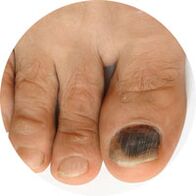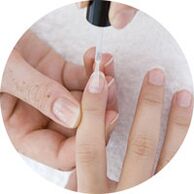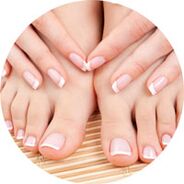Therapy for advanced forms of nail fungus lasts for more than a year. In the initial stages, however, the disease can be treated more quickly. To do this, create varnishes for the fungus on the nails of the hands and feet.
Treatment of fungal nails with varnish: indications and approach

Antifungal varnish is a device that has recently become important in the fight against nail fungus in the early stages of infection, i. e. in cases where the disc is less than 50% damaged.
The tool is comfortable and practical: unlike ointments, it does not wipe or wash off after drying.
However, antifungal nail polish is only recommended in 2 cases:
- In the early stages of the disease, when up to 30% of the disc is affected and there are up to 3 nails on one leg, arm. For wider and deeper foci, antimycotic tablets are not essential.
- To prevent onychomycosis. The coating reliably protects the nails from re-infection.
The drug can be prescribed for self-therapy or as part of a complex treatment.
How does antifungal varnish work?
The varnish used to treat nail fungi has a liquid structure on the feet and hands, is quickly absorbed and even penetrates microcracks. The active substance begins to destroy the cell membrane, enzymes and spores of the pathogen. After curing, the coating clogs the plate, preventing oxygen leakage. Without a basis for vital activity, fungi do not multiply and gradually die.
Mycologists also prescribe a drug to prevent fungal growth, especially after excessive sweating and acrylic extension. The resulting protective film prevents moisture, fungi and infections from entering the nail. In addition, the alcohol, oils and plant extracts in the composition are disinfected and dried.
Effectiveness of treatment
Varnish from nails is only effective in preventing and treating onychomycosis in the initial stages. The medicine forms a protective coating, quickly eliminating the infection and preventing it from appearing again. Complete recovery occurs after 3 months of therapy, with the first results noticeable after 7-10 days.
Tests should be performed a few weeks after the end of treatment. A laboratory test will show if the infection has completely disappeared and if a second course is needed.
Consult a mycologist or dermatologist before purchasing this product. The specialist will assess the extent and depth of the lesion, determine the stage and prescribe an appropriate varnish against the toenail or nail fungus.
How to apply varnish to treat nail fungus?
The frequency of use of a particular device is indicated in the instructions. As a general rule, the nails are varnished once every 2 days in the first month, twice a week in the second and once a week in the third. Therapy is continued until the healthy plate is growing.

The nail polish is applied to the feet and hands according to the following scheme:
- Pre - processing. Before treatment, the feet or hands are steamed in a soda-salt bath and washed thoroughly with soap and water. Then wipe the surfaces dry and have a hygienic pedicure or manicure. The nails are cut off, the top layer is polished with a nail file and wiped with alcohol.
- Application of funds. The nail polish from the fungus should be applied to dry plates with a brush or spatula. Operations should be performed slowly and carefully to avoid damaging the skin. In this case, the composition should cover the entire area of the nail.
- Post - processing. The medicine used should not be removed until the next procedure. However, after 10 minutes, after complete drying, a decorative varnish can be applied to the healing varnish. Whether the manufacturer allows this option can be found in the guide.
Contraindications
Therapeutic nail polish from the fungus is not absorbed into the bloodstream and cannot cause poisoning. However, the remedy is contraindicated:
- individual intolerance to ingredients;
- predisposition to allergic reactions;
- hypersensitivity to the skin;
- Children under 16;
- pregnancy and lactation.
Varnishes are prescribed with caution in diabetes mellitus, a disease of the immune system.
Side effects
Nail polish and hand varnish rarely cause side effects. In case of accidental skin contact, the following may occur:
- burning;
- redness;
- peeling;
- puffiness;
- irritation;
- itchy.
If an allergic reaction occurs, it is advisable to choose an analogue with another active substance.
Attention! Nail polish reduces the effectiveness of combined contraceptives.
Prevention

After complete recovery, the patient is often re-infected with the fungus. To avoid recurrence, the nails should be covered with varnish within one month after the end of the treatment.
Due attention should be paid to hygiene: wash feet and hands daily, change socks, dry shoes. Towels and slippers should be unique.
Remember: even the best anti-fungal varnish requires regular application. Without re-treatment, the coating gradually washes away. As a result, it will be a favorable soil for the development of fungi.
In conclusion, it should be noted that in the event of symptoms of nail damage caused by a fungal infection, and in particular if this is accompanied by favorable factors, qualified medical advice should be sought.
Setting up experiments with self-selection of means of therapy not only does not help in any way, but exacerbates the existing situation. It is very easy to get a gift in the form of mushrooms on your nails, but it is quite difficult to heal. Therapy is long and often complex, so self-medication should not begin with the course of the disease.






























